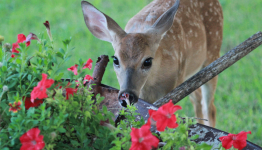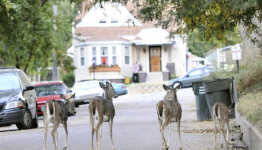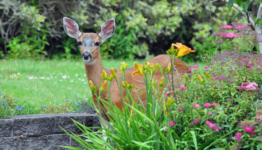Reproduction: Deer breed mostly between late autumn and early winter. The females have a pregnancy period of about 7 months, and can only give birth to one fawn at a time. Female deer live between 10 to 15 years, and are known to give birth to twins as they grow older. Female deer mostly give birth between late May and early June, and at birth, a fawn weighs between 3 and 6 pounds. Fawns are born with fur usually reddish brown in color, mottled by white spots. They are born with their eyes open and feeble legs, and it takes just 24 hours for a newborn fawn to learn to stand on its legs. It takes about a week or so for newborn fawns to develop their sense of smell. During this time, the best they can do is to flee from approaching predators. This continues until after a period of 3 to 4 weeks when they are matured enough to accompany the females in search for food. Female deer wean their fawns usually 4 to 6 months after birth, and by this time, the fawn would have replaced their coat of gray color with a coat of spotted pattern. Both the male and female fawn reaches sexual maturity at 1.5 years of age, but breeding does not commence immediately for the males as they would have to wait longer. When kept in a controlled environment, deer can live to 24 years, but lives to 9 to 10 years in central Adirondacks.
Means of communication: Deer communicates mostly via smell and sights too. Details about them like age, motivation and sex can be easily deciphered by smelling chemicals released from their tarsal (the region between their ankles and hind legs), pedal (the space that separates their toes), and preorbital (the corner of their eyes). A glandular substance which is secreted by their body is deposited to the ground when they press their hooves against the ground, rubbing their urine stained legs together and then stumping them on the ground, and rubbing their preorbital glands against branches and twigs. Visually, they communicate by doing things like bringing their head down while turning their ears in different positions, kicking with their fore legs against the air while standing on the hind leg and displaying the lateral side of their body whenever they sense danger. To mark their territory and wad off other deer, a male deer would dig shallow holes spanning 3 feet diameter wise with their hooves, and may in some instances use their urine to mark their territory. Territorial challenges are very common, and just like other animals, the weaker male would always have to leave. To scare off suspecting challengers, the male deer would raise his tail before then stomping the ground with his foot. While the adult deer moans or bawls, the fawn bleats loudly especially when they want to call the attention of their mother.
Social System: White-tailed deer are sociable animals. During summer and spring, the females as well as the fawns and yearling move in clusters while the male deer prefer to range for new territories. By autumn, yearling would disperse and move away by a distance of 5 miles to 25 miles in search of new territories and to  start a new social unit.
start a new social unit.
During summer, both the female and male establish their home within a range of 536 acres, but the male would expand their home range to 853 acres during autumn rut. Male whitetail deer are known to compete with each other for females, and would fight off any encroaching male that dares compete with his females. During winter, their home range would shrink to 338 acres per individual, and all members of a social unit would cluster together. Female deer are known to range with their fawns when they go foraging. Deer of the same yard often share the same tradition, and would return to their yard at least once in a year. Social hierarchies within each herd is determined by a host of factors including age, size, and sex. The male of the largest size is by default the leader of each herd, and is assisted by an adult female, while the fawns and yearlings are subordinates. During times of food shortage, deer at leadership position are accorded the highest portion of food. During winter, deer cluster together, and a square mile can hold 100 to 125 deer, but would shrink to 4 to 25 deer per square mile during summer.
If you want your area free of deer today, try the Nature’s Mace Deer Repellent. Backed by numerous university studies, this all natural formula has more of the strongest ingredients found in nature.
The technology uses a unique three prong repellency which targets the deers sense of taste, smell, and fear. Specifically chosen organic ingredients also fertilize your yard as a dual action repel and revive system. Click Here Now to try a Proven Effective Deer and Rabbit Repellent!











